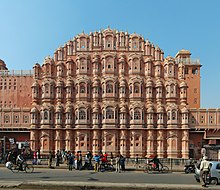Hawa Mahal
Hawa Mahal ( Hindi हवा महल havā mahal , "Palace of the Winds") is an architecturally extraordinary building in the old town of Jaipur , Rajasthan ( India ); it is part of the huge city palace of the local maharajas . Documenting the lavish lifestyle of the Rajput princes , the summer palace was built by Maharaja Sawai Pratap Singh in 1799 and is considered one of the main attractions of India.
architecture
The five-storey building - only about five to eight meters deep - with the facade dominated by countless jaroka balconies, consists of red and pink sandstone with decorations of quicklime . Its sole purpose was to enable the ladies of the harem to view the pompous pageants held in honor of the ruler or on religious festivals without being visible themselves. The facade facing the street contains 953 small, artistically designed and barred windows, which ensure constant, slightly cooling air circulation, hence the name Wind Palace ( hawa = wind, mahal = palace). Through the lattice windows ( jalis ) the women of the court could watch the goings on in the street unobserved. The many (semi) dome-like vaulted roofs, drawn down in the corners, correspond to the Bengali type , which spread in the 17th century via Mughal architecture to the Rajput palaces and merchant houses ( havelis ) of Rajasthan.
symbolism
Maharaja Sawai Pratap Singh was a follower of Krishna and so the overall view of the Hawa Mahal is reminiscent of the jeweled crown of the Hindu god. The innumerable small roofs and roof segments of the building are elevated by just as many gilded kalashas , an ancient symbol of good fortune in Hinduism .
Others
The novel Palace of the Winds by Mary M. Kaye and the film based on it (English: The Far Pavilion ) and the television series of the same name have nothing to do with the Hawa Mahal.
Web links
Notes and individual references
- ↑ These are loan words from the Arabic - Persian : Hawā (هوا) = "air"; Maḥall (مَحَلّ) = literally "place (of the solution [of problems])", in the Indian context also: "palace". See Junker / Alavi: Persian-German Dictionary , Leipzig 1970, p. 854; Wehr: Arabic dictionary for the written language of the present , Wiesbaden 1968, p. 179 f.
Coordinates: 26 ° 55 ′ 26 ″ N , 75 ° 49 ′ 36 ″ E


